Orientation
This post explores some of the constraints and ethical tensions experienced by white, middle-class, progressive mothers in the United States. In response to these, I propose a model for moral agency that emphasizes slow, deliberate community-building and experimental work to disaffiliate from heavy reliance on privilege. Lastly, I discuss what this case study shows us about moral agency more broadly and why this matters.
Opening Scenarios: Understanding the Context
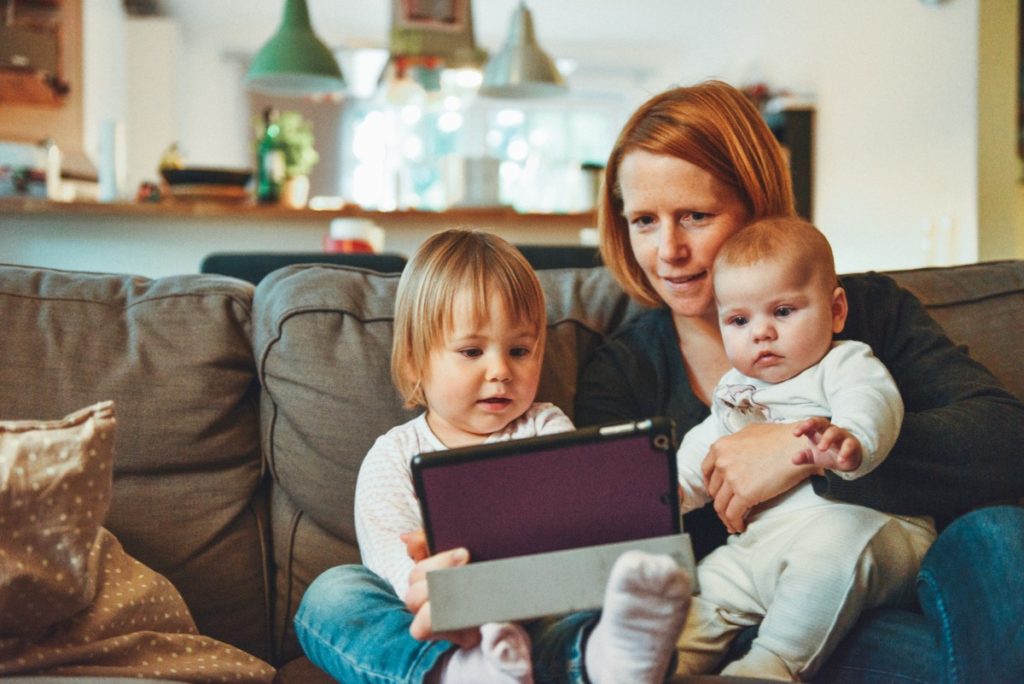
To get a feel for the context and constraints I’m analyzing, imagine yourself in the following scenarios:
Scenario 1: Imagine that you are a white mother of two young children. You and your husband are both doctors in community health clinics in Seattle. You met in college and were drawn to each other in part because of your mutual desire to make a difference in the world. The cost of living is high in Seattle, however, and despite your advanced training, you have chosen careers that pay comparatively lower than your physician peers. Starting when you bought your house and had your first child, you have begun to rely substantively on interest earnings from a substantial inheritance you received from a family member. This inheritance deeply subsidized the purchase of your house in a wealthy neighborhood, and contributes significantly to daycare expenses for your two children. You feel uneasy about it, given the unequal opportunities that allowed your family to amass this wealth, but also don’t know what you’d do if you didn’t have this support. Given your salary vs. daycare costs, you probably wouldn’t be able to work. Your current arrangement feels like the only reasonable choice.
Despite the privilege and access to wealth of this scenario, this person is not alone. Nearly 60% of parents provide financial support to their children after college graduation, and people born in 1980 or later are significantly less likely than earlier generations to earn as much or more than their parents. Meanwhile, housing and college costs continue to rise faster than both wages and inflation.
Scenario 2: You are a white, middle-class mother living in a historically multi-ethnic and progressive city. You are aware of the ways that your family is contributing to the gentrification of the area, and know that the deep segregation and inequality of local schools is part of this problem. You want to actively work against these forces, so you enroll your child in an elementary school where the vast majority of the children are black and Latino, and most qualify for free or reduced-price lunches. After a couple of years, however, problems begin to emerge. Not only is the school significantly under-resourced; your child is also routinely praised for being particularly “smart”–which you feel has to do with both his white skin and his access to books and other resources at home. Conflicted and with a certain amount of regret, you eventually move him to a well-funded, majority-white school in the very same neighborhood.
In this scenario, your experience would be very similar to that of Eleanor Wohlfeiler, a mother in Oakland, CA profiled by Zaidee Stavely of KQED News. Notable about Wohlfeiler’s experience is that she and her family seem to have made the decisions about school placement on their own, rather than as members of a community group or even an informal network of parents. This is in line with sociologist Robert Putnam’s now-famous concept of “bowling alone,” the decreasing social and civic group participation among Americans in the last 30 years that has led to increased isolation of nuclear families and decreased community power.
Two Competing Goals, Three Interwoven Constraints
Two Goals in Tension
The mothers in these scenarios are implicitly working towards two different goals which, in a context of constraint, are revealed to be somewhat in tension with one another:
- The goal of providing children with the elements of a middle-class “good life”: a safe neighborhood, enrichment activities, high-performing schools, and ultimately a college education with as minimal debt as possible
- The goal of ordering one’s life in a way that contributes to progressive ideals of justice and equal opportunity
Three Interlocking Constraints
The following constraints highlight the tension between these goals, leading many white progressive families to lean heavily on racial and class privilege (violating Goal 2) in order to achieve Goal 1.
The first two constraints are felt by parents across lines of race and class, and it’s important to note that white middle-class families are less impacted by them than lower-income families and those who do not benefit from generational wealth. Yet the fact of something being less constraining does not mean it is not experienced as a constraint, which is particularly notable here because the combined “infrastructure of constraint” created by these first two elements may discourage risk-taking or the creative questioning of social norms.
- Constraints of time, energy, infrastructure: children take up time and energy, and we don’t have good structures in this country to support families with family leave, childcare support, etc.
- Financial constraint and insecurity, both perceived and real: wage stagnation amid rising costs, decreasing workers’ rights across all sectors
The final constraint is most clearly associated with whiteness and middle-class ideals:
- Constraining logics: the tight coupling of “good life” or “flourishing” with the attainment of certain middle-class goods, obtained through a very narrow set of means (the “right” neighborhoods, daycares, schools, colleges, etc). This is tightly interwoven with unacknowledged racism: assumptions about which schools and neighborhoods will deliver the goods. The actions that flow from these assumptions often conflict with stated values about “diversity.”
Naming this constraint, and its particular identification with whiteness, builds on the work of legal theorist Cheryl Harris (1994) and theologian Kelly Brown Douglas (2015). Harris and Douglas have argued in similar ways that the most salient element of whiteness is the assumption of a right to own and claim property, to “stand your ground” in Douglas’s formulation. In this logic, to be white is to own things, and to own things is to flourish. For those of us raised (almost always implicitly) in this logic, it can be difficult to see or accept models of flourishing that do not include the accumulation of enough wealth to live a respectable middle-class life.
The result of these combined constraints and competing goals is often a kind of paralysis. Within these constraints, it is often impossible to build a “good life” that does not also contribute in substantive ways to inequality and injustice. But what can we do, isolated and harried as we often are?
A Counterintuitive Model for Moral Agency: Communities that Imagine the Impossible
Guiding Principle: Moving Counterintuitively
In order to get out of this paralysis, we may have to move in surprising and counterintuitive ways. Here I take inspiration from Lewis Carroll’s Through the Looking Glass, a tale that foregrounds the power of paradox and imagination, learning to move and believe in ways that seem impossible. Consider the following excerpts [note: given the books’ publishing dates, all images from Carroll’s works are now in the public domain]:
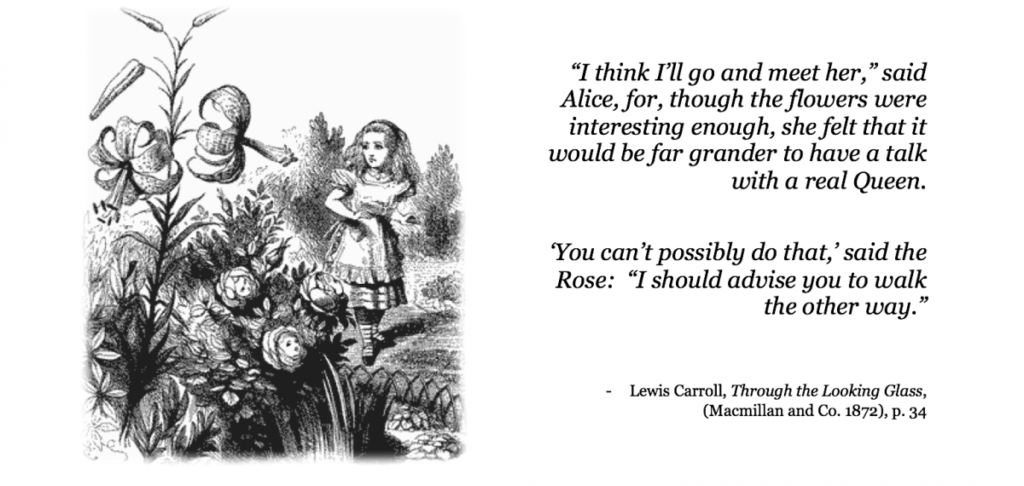
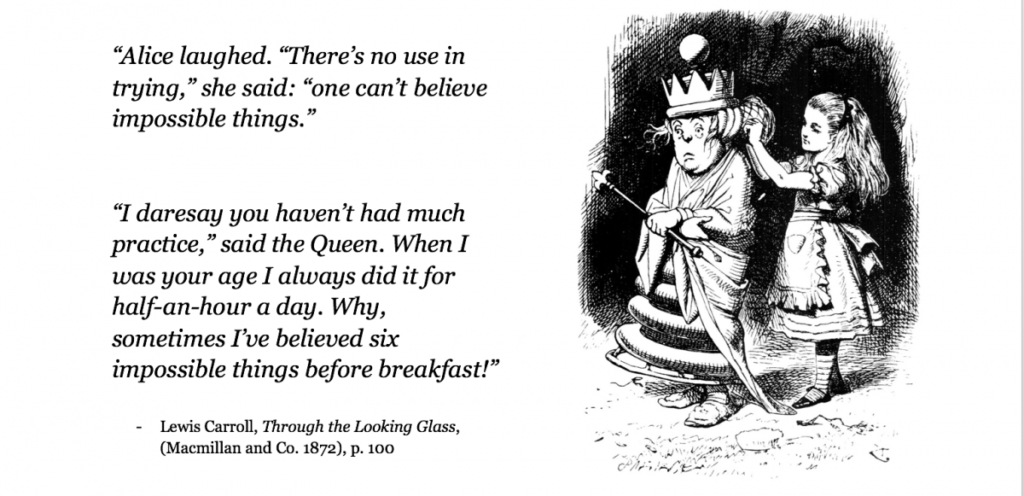
In these passages which unfold within the looking-glass world, Alice is challenged to move and think in unusual ways. In order to reach the Queen, she must “walk the other way” — walk away from the Queen in order to find her. This, it is slowly revealed, is the way movement works in the looking-glass world: one reaches goals by physically moving away from them. Later, in conversation with a (different) Queen, Alice is told that with “practice,” believing the impossible becomes much easier.
What can we learn here?
- Ethicist Sharon Welch (2000) argues that those of us raised in white, middle-class environments inherit a “control ethic” approach to solving social problems: we want to go out and DO something, fix it, move directly into the thick of the problem via intervention.
- What Alice’s new world teaches us: No. Sometimes, you have to walk in the opposite direction to get where you’re trying to go. You have to learn to move in new ways, counterintuitive directions. You have to be willing to experiment with things that feel impossible—and this takes practice.
- So, what does counterintuitive moral agency look like for white middle-class mothers? My proposal involves slowing down and building community that supports critical self-reflection and actions within our own lives (more on this below!).
Threads of Inspiration

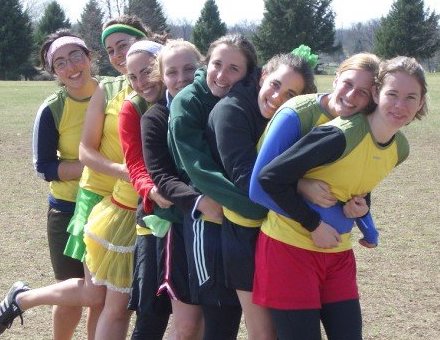
The model I propose below involves regular small-group meetings among women (neighbors, friends, starting where we are) with time dedicated both to mutual support and exploration of possible small ways to disaffiliate from privilege and align with goals of social equity. Although in some ways I’m proposing something new, I draw on centuries of women’s gatherings, both formal and informal, as inspiration.
Two primary strands of inspiration are:
- Women’s groups that emphasize “the personal” via community building and mutual support. These gatherings include student groups, sports teams, church organizing committees, stitch-n-bitch circles, and the informal groups that arise out of traditionally feminized household work (i.e. cooking or doing laundry together).
- Women’s groups that are more outwardly political in their orientation and activities. These include feminist consciousness raising circles (see MacKinnon 1982), the Combahee River Collective, and the more recent Black Feminist Organizing Schools run by Black Feminist Future.
Of course as the feminist rallying cry reminds us, the personal is political. These two strands are interrelated parts of one whole–and the model below reflects the need for both.
The Model
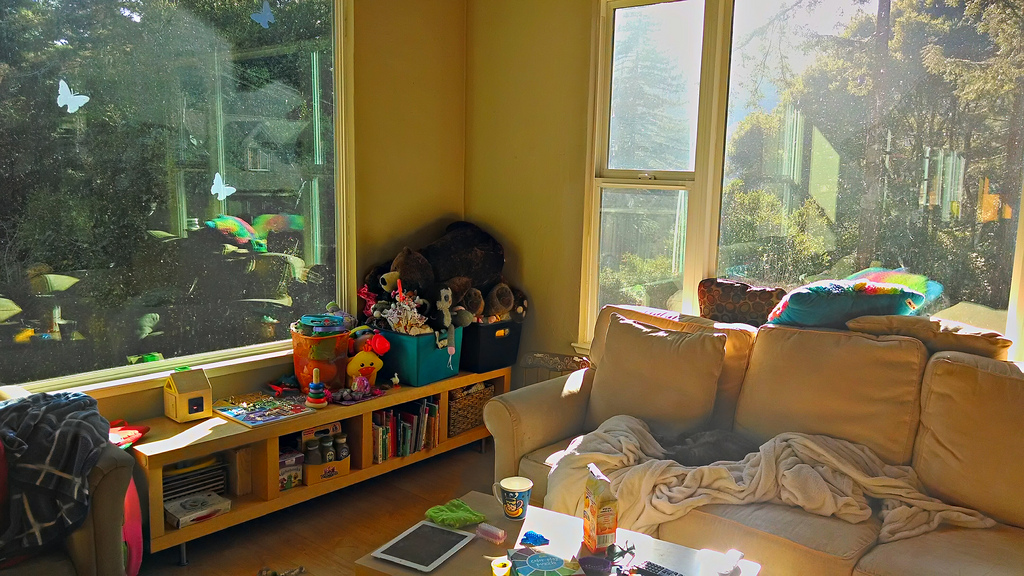
The moral agency I envision takes place in a “well lived-in” living room. (Image by Tyler Karaszewski, CC 2.0)
The practice I propose as a model of moral agency is a combination of the support group and the political model, with a twist: the political involves an examination of one’s own participation in structures of power. I envision regular small-group meetings of women gathered in each other’s homes (or virtually, in a pandemic), perhaps starting with a small group of friends. The logistical elements, such as exact length, frequency, and childcare arrangements, could be decided by the groups themselves.
The meetings would be divided into two primary sections, as explained below:
| Section | Emphasis | Possible Activities or Questions to Hold |
| Part 1: Community building (1 hour) | Slowing down, checking in, getting to know and support one another (a feminist good in and of itself!) | * Sharing food and/or a meal * Individually checking in about the time since the last meeting * Watching amusing YouTube videos together * Naming “the best part of my week” or “what I’m grateful for” * Rituals or activities that build sacred space together, such as building a communal altar (for groups interested in having spiritual engagement as part of their practice) |
| Part 2: Stretching into self-examination and action (1 hour) | Using the space of trust and community to envision, plan, and troubleshoot experiments in disaffiliation from privilege | * Individual and collective reflection on how/where we might be benefiting from arrangements that harm others, where we feel room to experiment with making a (small, at first) change * Query (from Quaker tradition): “where are expectations of what ‘one should provide for one’s children’ harming me, and how might my attempts to achieve them be harming others? * What is one area where I feel I can try something a little different?” * After individual reflection, time for making a commitment to the group about one “experiment” to try before the next meeting * In later meetings, time for check-in about how recent experiments/projects have been going * Possible early-stage examples of practices to try: prioritizing black-owned businesses over trendy locations that aid in gentrification, swapping one enrichment activity the children participate in for weekly community service * Down-the-road possibilities to work up to slowly, as community support builds: sending children to different schools, giving away a large chunk of an inheritance |
Important Caveat
For this model to work well, it must not be the only form of activist practice in which white women are engaged. It is predicated on participants possessing some knowledge of the ways that racism and structural violence work, and committing to continually learning and uncovering more about our participation in them. This cannot be done solely among insular race and class groups; further, a crucial part of “moving counterintuitively” for white people is the practice of stepping back and letting activists of color lead. A prime example of what can happen when white parents fail to take this crucial step can be seen in the first segment of the “Nice White Parents” podcast from the New York Times. In this episode, a group of white parents organizes an effective takeover of a primarily non-white school by banding together, without consulting the school’s existing PTA, to demand and fundraise for a dual-language French program that primarily benefits their own children. Thus, this practice of community building and self-examination is a necessary complement to ongoing learning and involvement with POC-led activism.
Why Is this Moral Agency?
This proposal might sound interesting. But what does it have to do with “moral agency”? Doesn’t that term mostly come up in legal proceedings relating to whether someone can be held accountable for his/her actions?
It does–but that’s what we’re here to complicate. During the “Moral Agency Under Constraint” Fall 2017 graduate seminar at Emory University, students worked in groups to generate new definitions of moral agency. In general, these definitions aimed to expand on traditional understandings of the term that center on the capacity of persons to discern between “right” and “wrong” (often with legal implications). The following definition was generated by Cara Curtis, Isaac Horwedel, Sarah Kothe, and Quin Rich, and is the primary definition with which this project engages:
Moral agency grows from reflexivity, which is the ability to reflect on our situated being-in-the-world … Moral agency is directed toward (or against) some conscious or unconscious conception of the good.
The model proposed here intentionally involves both reflection and action toward the good–with an emphasis on re-orientation towards new sets of goods that can be found over time through practice of community building.
Worth noting, too, is that although this slow, indirect model of moral agency may be counterintuitive for those of us raised within a “control ethic” mindset, it is hardly unprecedented. Those with less access to power, in particular peoples that have undergone colonization and enslavement, have been constructing indirect and non-interventionist forms of moral agency for centuries. Further reading on this can be found in two relevant examples: Womanist Katie Canon’s Katie’s Canon (especially Chapter 4), and Saba Mahmood’s Politics of Piety.
Why Do We Care?
Through this case study, we’ve taken a deep dive into one ethically fraught context: white middle-class progressive families in the contemporary United States. We’ve examined mothers as moral agents in this space, and one proposed model for a kind of counterintuitive agency that can help build community–and with it, new spaces for new “goods” to emerge that do not rely solely on the achievement of middle-class ends.
But why does all this matter? What does it teach us more generally about the nature of moral agency and constraint?
A few important takeaways:
- Constraints exist in every community. People in communities of power and privilege generally experience less brutal forms of constraint than those in poor and marginalized groups. Yet, as this case study shows, the “felt constraints” of those in dominant groups can have huge impacts on both the dominant and the marginalized. They are thus important to acknowledge and address–even if the intervention is to reorient people in dominant groups toward new goals, rather than to mitigate the constraints themselves. Relatedly…
- A sense of paralysis, especially for those in social locations of power, is not necessarily equivalent to a lack of agency. Moral paralysis may mean, instead, that we need to move counterintuitively to start to untangle ourselves from the mess of conflicting goals, constraints, and opportunities in our social field.
- Appropriate moral agency will look different in different contexts, and may depend on identity as well as social location. For those who hold the assumption that problems can often be solved quickly and fully, moral agency may most appropriately take the form of slow, circuitous steps that do not initially seem to be leading toward the desired goal.
- As Alice teaches us in the worlds created by Lewis Carroll: imagination, paradox, and the “impossible” are our friends in moral agency. We never know where a side-journey with the Cheshire Cat and the Live Flowers, or conversations in the midst of a messy living room, might take us.
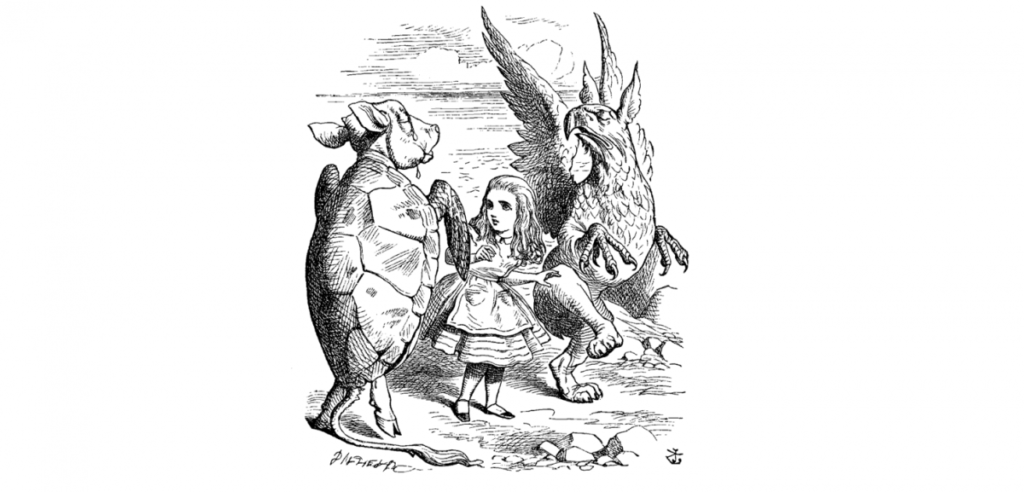
Want to know more about this author? Click here!
Bibliography
Works cited and consulted
Alexander, Michelle. 2012. The New Jim Crow: Mass Incarceration in the Age of Colorblindness. New York: The New Press.
Cannon, Katie Geneva. 1998. Katie’s Canon: Womanism and the Soul of the Black Community. New York: Bloomsbury Academic.
Carroll, Lewis. 1866. Alice’s Adventures in Wonderland. New York: Appleton and Co.
———. 1872. Through the Looking Glass, And What Alice Found There. London: Macmillan and Co.
Cohen, Patricia. 2015. “Middle Class, but Feeling Economically Insecure.” The New York Times, April 10, 2015, sec. Economy. https://www.nytimes.com/2015/04/11/business/economy/middle-class-but-feeling-economically-insecure.html.
“Combahee River Collective (1974-1980) | The Black Past: Remembered and Reclaimed.” n.d. Accessed November 30, 2017. http://www.blackpast.org/aah/combahee-river-collective-1974-1980.
Douglas, Kelly Brown. 2015. Stand Your Ground: Black Bodies and the Justice of God. Maryknoll, New York: Orbis Books.
Goudreau, Jenna. 2011. “Nearly 60% Of Parents Provide Financial Support To Adult Children.” Forbes, May 20, 2011. https://www.forbes.com/sites/jennagoudreau/2011/05/20/parents-provide-financial-support-money-adult-children/#6f8bbe521987.
Harris, Cheryl I. 1993. “Whiteness as Property.” Harvard Law Review 106 (8):1707–91. https://doi.org/10.2307/1341787.
Hartigan, John. 1997. “Establishing the Fact of Whiteness.” American Anthropologist 99 (3):495–505. https://doi.org/10.1525/aa.1997.99.3.495.
Horne, Rebecca M., Matthew D. Johnson, Nancy L. Galambos, and Harvey J. Krahn. 2017. “Time, Money, or Gender? Predictors of the Division of Household Labour Across Life Stages.” Sex Roles, September, 1–13. https://doi.org/10.1007/s11199-017-0832-1.
Jackson, Abby. 2015. “This Chart Shows How Quickly College Tuition Has Skyrocketed since 1980.” Business Insider. July 20, 2015. http://www.businessinsider.com/this-chart-shows-how-quickly-college-tuition-has-skyrocketed-since-1980-2015-7.
Leonhardt, David. 2016. “Opinion | The American Dream, Quantified at Last.” The New York Times, December 8, 2016, sec. Opinion. https://www.nytimes.com/2016/12/08/opinion/the-american-dream-quantified-at-last.html.
Livingston, Gretchen. 2016. “Among 41 Nations, U.S. Is the Outlier When It Comes to Paid Parental Leave.” Pew Research Center(blog). September 26, 2016. http://www.pewresearch.org/fact-tank/2016/09/26/u-s-lacks-mandated-paid-parental-leave/.
MacKinnon, Catharine A. 1982. “Feminism, Marxism, Method, and the State: An Agenda for Theory.” Signs: Journal of Women in Culture and Society 7 (3):515–44. https://doi.org/10.1086/493898.
Mahmood, Saba. 2011. Politics of Piety: The Islamic Revival and the Feminist Subject. With a New preface by the author edition. Princeton, N.J: Princeton University Press.
Martin, Emmie. 2017. “How Much Housing Prices Have Risen since 1940.” CNBC News. Accessed December 1, 2017. https://www.cnbc.com/2017/06/23/how-much-housing-prices-have-risen-since-1940.html.
Mishel, Lawrence, Elise Gould, and Josh Bivens. 2015. “Wage Stagnation in Nine Charts.” Economic Policy Institute. http://www.epi.org/publication/charting-wage-stagnation/.
“Moral Agent.” n.d. Ethics Unwrapped (blog). Accessed December 1, 2017. http://ethicsunwrapped.utexas.edu/glossary/moral-agent.
Oliver, Melvin, and Thomas M. Shapiro, eds. 2006. Black Wealth / White Wealth: A New Perspective on Racial Inequality, 2nd Edition. 2nd edition. New York, NY: Routledge.
Omi, Michael, and Howard Winant. 2014. Racial Formation in the United States. 3rd edition. New York: Routledge.
Pew Research Center. 2016. “On Views of Race and Inequality, Blacks and Whites Are Worlds Apart.” http://www.pewsocialtrends.org/2016/06/27/1-demographic-trends-and-economic-well-being/.
Plan C. 2014. “We Are All Very Anxious.” April 4, 2014. https://www.weareplanc.org/blog/we-are-all-very-anxious/.
Putnam, Robert D. 2001. Bowling Alone: The Collapse and Revival of American Community. 1st edition. New York, NY: Touchstone Books by Simon & Schuster.
Ross, Andrew. 2009. Nice Work If You Can Get It: Life and Labor in Precarious Times. First Edition, 1st Printing edition. New York: NYU Press.
Stavely, Zaidee. 2016. “Two Moms Choose Between Separate and Unequal Schools in Oakland.” KQED News (blog). August 30, 2016. https://ww2.kqed.org/news/2016/08/30/two-moms-choose-between-separate-and-unequal-schools-in-oakland/.
Welch, Sharon. 2000. A Feminist Ethic of RISK. Revised edition. Minneapolis, MN: Fortress Press.
Wilson, Julie A., and Emily Chivers Yochim. 2017. Mothering through Precarity: Women’s Work and Digital Media. Durham : Duke University Press.
Love it
very interesting information for me. may i share this article?